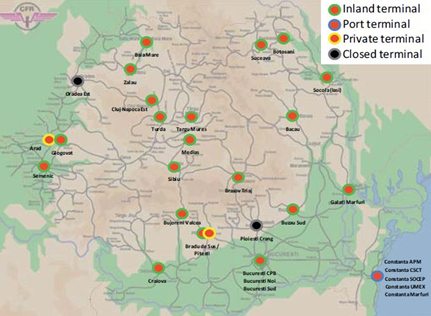About the Romanian network
The Romanian railway infrastructure is owned by the national transportation company - CFR SA - and gathers 10 781 km. The Romanian Railroad Network
The Romanian Railroad Network (Source: SNCFR S.A.)
Generally speaking, the railroad network is underdeveloped and cannot claim to fit European standards, the main cause being the lack of investments. This situation is also due to the fact that, in general, less attention was given to the development of roads to the disadvantage of railways. Since 1990 until today, the railway has lost approximately 5 percent in length, reaching 10 800 km from 11350 due to closing some lines which were rarely used. Despite this, the Romanian government considers the country to be a privileged one due to its favourable geostrategic position, thus being considered a key point in the continental and intercontinental transportation along the main lines to the West-East and North-South directions since three out of the ten trans-European corridors cross it. Actually, Romania is placed at the intersection between two of these corridors; corridors IV and IX are similar in terms of railways and roads and corridor VII is represented by the Danube.
• Corridor IV Dresden/Nurenberg - Prague - Vienna - Bratislava - Gyor - Budapest - Arad - Bucharest - Constanta / Craiova - Sofia - Thessaloniki / Plovdiv - Istanbul)
• Corridor IX (Helsinki - Vyborg - St. Petersburg - Pskov - Moscow - Kaliningrad - Kiev - Ljubashevka/Rozdilna (Ukraine) - Chisinau - Bucharest - Dimitrovgrad - Alexandroupolis)
• Corridor VII (Danube -North West - South East).
 Pan-European Corridors in Romania
Pan-European Corridors in Romania (Source: The Ministry of Transport)
The railways on corridor IV are electrified, thus benefiting from double lines on most of the Romanian territory: approximately 99% of the surface is almost completely electrified and 98% have double lines. Despite this, a significant surface of the Romanian network between Bucharest and Giurgiu, at the Bulgarian border is not electrified. This represents an important aspect because it is intended to be used in the future for the transit to and from Turkey. It is also part of corridor IX which is electrified and has only 79% railways. On both corridors the maximum speed for freight trains is 95 km/hour and on limited distances it may reach 120 km/hour (between Bucharest and Campina, on corridor IV and between Bucharest and Ploiesti on corridor IX). Moreover, the works which are now performed on corridor IV between Bucharest and Constanta only manage to slow down transit. In the recent years, the railways infrastructure in Romania has suffered from a terrible lack of maintenance and investments, and priority was given to pan-European corridors and roads. These circumstances have determined the quality deterioration due to the numerous capacity and speed restrictions along many sections similar to the ones mentioned within corridor IV.
There are at least 30 intermodal terminals in Romania. The great majority used to be the property of CFR Marfa and are now operated by CFR Transauto, the latter being responsible for the transportation to and from terminals. In 2004, Transauto, a branch of CFR Marfa at the time, was privatized together with all its lands and terminals, whose property rights are debated today by the two companies, a fact which only prevents fundraising. There are also some private terminals in Romania: the four terminals in the Constanza port and the one in Oradea (ICA Romania). According to some market surveys, a terminal has already been closed due to precarious infrastructure as well as to lack of demand. The property and responsibility for operating intermodal terminals, the great majority built during central administration has been moved from the CFR Infrastructure authority to CFR Marfa. The latter is currently responsible for its organisation and functioning. This aspect is unusual for the European context, where the majority of states have decided to transfer them either to an infrastructure manager or to some private companies.

Terminals for unaccompanied intermodal transport in Romania
(Source: SNCFR S.A.)
The biggest and most important terminals in terms of goods handling in Romania are the container terminals in Constanza. These managed to handle, together with the interior railway transport, a number of 180000 TEU in 2007. Among these, the most advanced one in terms of infrastructure and handling and organization capacity of the whole process is the Constanza Sud Agigea (CSCT) Container Terminal, owned and operated by the DP World Constanza company. In 2004, this terminal had three lines of 616m and two terminal cranes. Meanwhile, the terminal has grown due to the high percentage of the railway traffic.
The next inland terminals according to their importance are the one in Pitesti, owned by Dacia-Renault and the one in Bucharest, these handling a volume of 5000 TEU annually. All the other terminals are a lot smaller and, being unable to transport the goods on the railway, they use trucks.
The design of most terminals is a standard one, usually comprising two railways placed under one or two rail mounted gantries.
Railways are extremely short, with a length between 100 and 300 metres. Most of them were built more than 30 years ago, at the end of the 1970s, when the maximum speed for trucks was 100km/h. Meanwhile, they have not benefited from any appropriate usage or maintenance. Therefore, both their technical condition and infrastructure are far from optimal. However, since the demand for handling services at most terminals has been rather low, the process of their modernization is not seen as profitable investment. Actually, there are too many terminals and too little traffic. Moreover, there are numerous problems related to land property which consistently contribute to discouraging any terminal improvement intentions in Romania.
This page represents the practical component of the PhD thesis entitled "Research regarding implementation of dryport in Romania",
within the Doctoral School of Economics, Faculty of Economics and Business Administration, Alexandru Ioan Cuza University of
Iasi, Romania.


